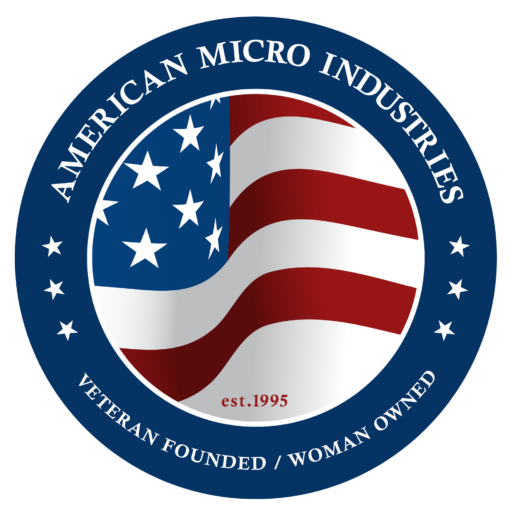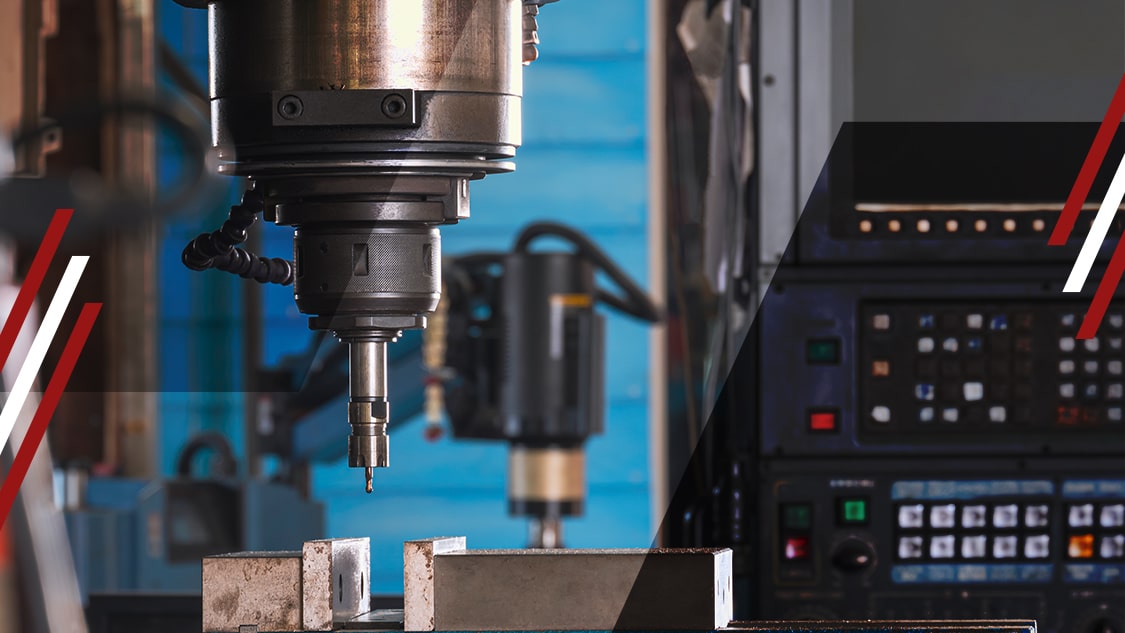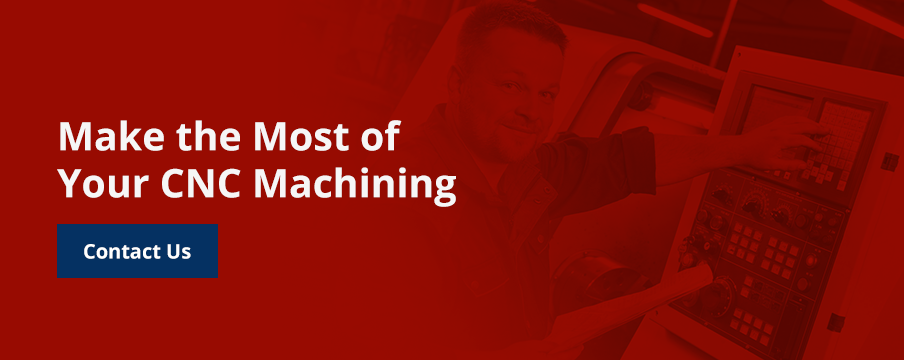While taking advantage of computer numerical controlled (CNC) machining saves your operation time in creating products, you should always be looking for ways to make your work better. Improving the precision of CNC machining in your facility increases their accuracy, but there are other ways to get more from the parts you have machined. Consider how you use your in-house CNC equipment and recognize how to balance in-house and outsourced work. Understanding these factors can help you get the most from your machines and the precision you require from the created parts.
What Is CNC Precision Machining?
CNC precision machining uses computerized instructions to cut away excess materials, leaving behind a finished shape or part. It can cut, mill and turn an array of different materials, but it is often used for metals. The beauty of CNC machining lies in its precision. Since a computer makes the cuts instead of a human, CNC machines can achieve much higher levels of precision.
The ability to meet tight specifications makes CNC machining operations ideal for industries that need high precision, like aerospace and medical device manufacturing. Of course, it’s also great for general manufacturing, offering highly accurate cuts in a short amount of time.
Although they are highly accurate, CNC machines use tolerances to determine how much the part can deviate from conventional standards. Some products, like those aerospace and medical applications we mentioned, likely require tighter tolerances than a manufacturer of, say, children’s toys or furniture.
Benefits of Improving Positional Accuracy of CNC Machines
When you upgrade your equipment to improve accuracy, you benefit in multiple ways. Exactly which advantages your operation reaps from the changes will depend on your current workload and the updates you made to your existing equipment. Upgrading now will keep your business from falling behind as technology and demand both push for an increase in precise parts from machining.
Learn More About Our CNC Machining Services
1. Faster Turnaround
One of the main reasons for improving the positional accuracy of CNC machines is the time it saves on your projects. More accurate cutting prevents your shop from having to redo jobs. Plus, automating many of the aspects of machining, such as setting tools into place, reduces the time each task you take requires. If you use the parts created on machining, more efficient operations will reduce the time you have to wait for your completed project.
2. Data
Once you control for variability in products, you save time on the precision measuring of machined parts. Variability can affect the initial accuracy of a part and the ability to create exact replicas of it. Changing your equipment to reduce these variables will ensure accurate and repeatable results. Plus, you shouldn’t have to measure every finished part.
For instance, when increasing accuracy, you will need to reduce human input. By automating the process, you reduce the chances for errors to occur, allowing for more exact replication with each part machined. Because the number of errors has a finite amount, you can reach a state of high precision with your equipment by controlling potential mistakes.
Though you may not need to measure every part, you should still use laser measurements and ballbar inspection to verify the accuracy of your processes. The information from these measurements may help you predict better when to maintain the machine or when it needs adjustments to improve efficiency.
Improving the Precision of CNC Machining
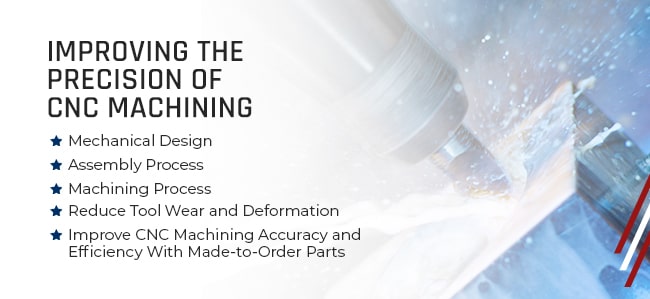
Follow these methods of improving CNC machine accuracy and productivity. By controlling both, you attain a higher level of precision with your work. You will improve your productivity, get the most out of the equipment you have and increase your project precision.
1. Mechanical Design
The complexity of the part design and the number of sides your machine works on affect the speed, precision and accuracy of your work. One of the fastest ways to improve your CNC machining speed and accuracy is through an upgrade to a five-axis machine. If you have a three-axis device, for instance, you may waste time with extra setups during production time.
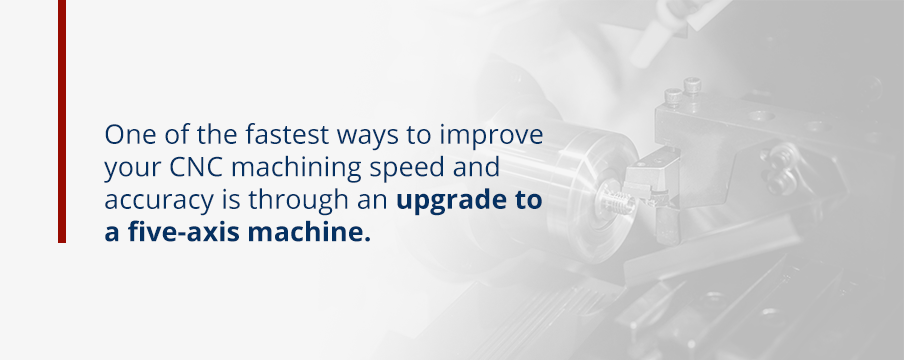 When you have a machine that works on more axes, you can save time for a speedier turnaround of part production. Also, you won’t need to worry about mistakes made during multiple setups.
When you have a machine that works on more axes, you can save time for a speedier turnaround of part production. Also, you won’t need to worry about mistakes made during multiple setups.
For operations that already have a three-axis machine, integrating work on five sides can happen if you add a two-axis table to move the part. This 3+2 configuration offers the most straightforward, least expensive way to get machining on more sides of the component. However, if you must work on heavy or large parts, the table may not hold them as needed, and an upgrade to a five-axis machine may prove the best option for your operation.
2. Assembly Process
When getting the machine ready for the job, using tool presetters can make the work more precise. These add-ons measure the accuracy of the tool placement in under a minute. Compare this to the more than one hour it takes for a machinist using a touch probe to set 15 tools for a project.
With the use of presetters, your precision also improves because the system can establish the exact position of the tool for more accurate cutting. With more precise positioning of the tools, your work does not suffer from errors made during manual setting.
Despite the notion that tool presetters only work for large operations, any worksite that frequently changes tools will save time by using these devices.
In addition to having the tools set precisely, you must ensure the work does not fall or slip during machining. Workholding devices prevent accidents, and if you have a metal piece, an electro-permanent magnet may serve this purpose. American machining facilities have used these devices for almost 25 years, since their introduction in the mid-1990s, and they remain popular options today.
Using an electrically activated magnet to hold metal pieces is a wise idea when working with thin parts that could move or bow during cutting or milling. With a workholder to secure your components, cutting becomes more precise because the pieces do not move during machining. A workholder holds the part steady, but you do not have to use a magnetic version. Any workholder that secures the part is a better choice than not using one, especially for smaller pieces that can slide around during machining.
3. Machining Process
You can improve the machining process in several ways. First, consider your personnel. If your workers lack organization in how they operate the machines, they may waste time or make mistakes. If you upgrade your CAM software, ensure all your workers have full training on how to use it. Failing to input information into the system will lead to the machine making errors that originated from having incorrect data.
Upgrading your software and hardware to accommodate higher levels of precision will also improve your processes. For example, one tool-making company had not updated their equipment since 1987. When they upgraded to new software and hardware, they tapped into their machine’s newfound ability to look further ahead than before. Now, the equipment could predict where it needed the tools to move by looking forward up to 1,000 lines of point data in the program. Because the computer can predict where it needs to place the tools in the future, it becomes more efficient and accurate throughout machining.
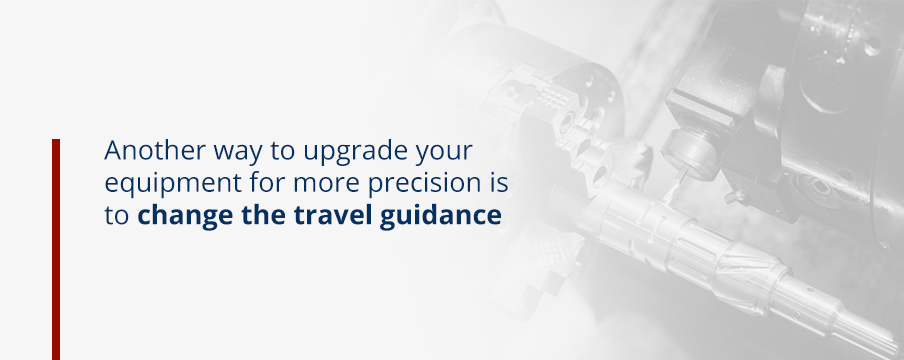
Another way to upgrade your equipment for more precision is to change the travel guidance system. The accuracy of the travel system depends on how much it mitigates roll, pitch and yaw — movements around the X, Y and Z axes, respectively. A high-precision travel guidance system with low tolerances for height, width and parallelism will cost you increasing amounts as the tolerances decrease. However, the lower the tolerances, the more precision you will get. If your budget does not allow for an ultra-precision guidance system for your equipment, consider outsourcing the task.
How well you have the machine bed supported also plays into the accuracy of your precision CNC machining equipment. The bed supports the moving parts of the machine, and to ensure CNC accuracy, you must have a flat, thermally stable and stiff bed that absorbs vibrations. To achieve these traits, you may need to grind down the surface where the device’s guide ways mount.
The interaction between the bed and the foundation affects the equipment’s accuracy. If you have a machine that takes up one square meter of floor space and has a very stiff bed, you only need three mounting points.
Placement of the supports of the bed at the mounting points is essential for reducing sagging. Even the stiffest of beds will imperceptibly sag between points. Ideally, have the bed feet at a distance from each other about 60% of the bed’s length. These are the Airy points, which are points for supports that help to minimize sagging of the bed. Place the third support centered between the two others. Reducing the sag of the bed ensures accuracy when machining.
4. Reduce Tool Wear and Deformation
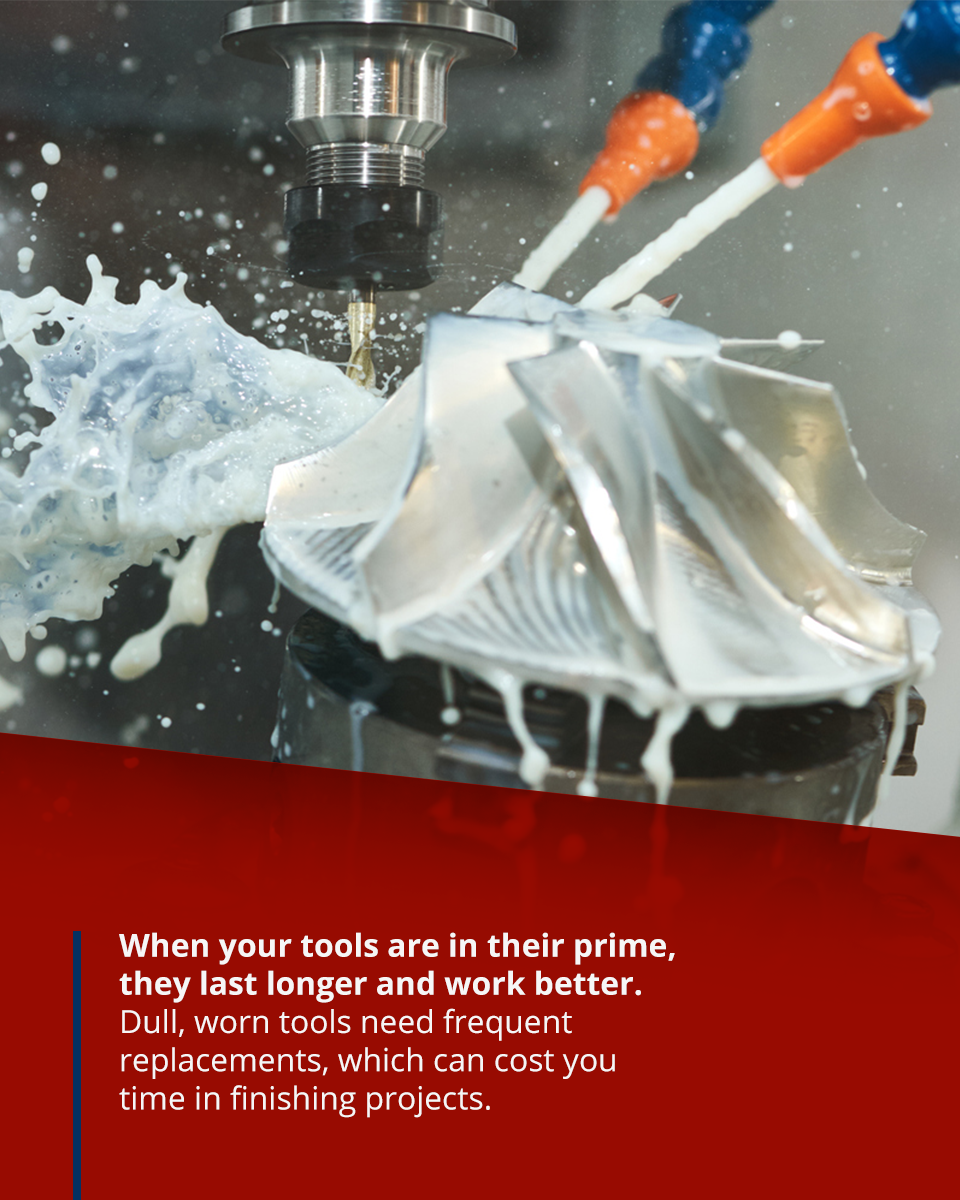
When your tools are in their prime, they last longer and work better. Dull, worn tools need frequent replacements, which can cost you time in finishing projects. You have several ways to reduce the wear and tear on your CNC machining tools and avoid unexpected breakdowns.
When it comes to unplanned downtime, in 42% of cases, equipment failure caused the problem. Unplanned downtime costs 10 times more than planned work stoppages for maintenance. Keeping up with equipment maintenance can prevent many of these problems.
First, choose predictive maintenance when possible. Unlike scheduled maintenance — also called preventive care — that occurs regardless of the equipment’s condition, predictive maintenance uses data to determine when to best perform upkeep tasks. Predicting when to perform care tasks on your CNC machining equipment reduces unnecessary maintenance while preventing unplanned downtime from a machine breakdown.
Preventive maintenance still ranks better than responding to breakdowns. If you don’t have the available data to predict the best times to service your equipment, at least follow the manufacturer’s guidelines for a preventive maintenance schedule.
Always examine the state of your tools, filters and spindles when conducting any regular maintenance. These parts may require frequent replacements if you regularly use the equipment. Ensuring your machinery has quality parts in it will help you get the most from your machine’s accuracy.
Another way to reduce tool wear is to choose harder tools where possible. If you select the softest tool that you can use for machining parts, it will wear out faster. Though the most durable tools come with comparable price tags, you will have more precise machining solutions from tools that remain sharp. Dull, worn-out tools cannot achieve high levels of precision, no matter how accurately you set up the machine.
Lastly, if you have specific projects that require extra-durable tools that you do not want to invest in, consider outsourcing the work. You do not have to choose a third-party machine shop for all your work, but for highly precise parts or those that require specialty tools, having someone else do the work helps keep the wear and tear off your in-house equipment.
5. Improve CNC Machining Accuracy and Efficiency With Made-to-Order Parts
Achieving high levels of precision and repeatability costs a significant amount of time and money. Because the cost often makes upgrades to high or ultra-high levels of accuracy unattainable, not all machine shops offer these services. When orders for high-precision parts come in, some companies will outsource the jobs to shops that can craft the pieces with the required accuracy. It is a business strategy that can help you improve your shop’s operations without turning down work.
You don’t need to choose made-to-order parts for all your work. You may be capable of fulfilling most of the orders you get. However, specialty machine shops can offer you a more extensive range of materials and higher levels of accuracy than you may have access to. For high-precision projects or prototypes, you can benefit your operation by choosing this option.
Choosing a third-party shop for specific projects can save you more than money. When you select made-to-order parts for some projects, you reduce the wear on your in-house equipment. Since you do not need to run your machines as often, you save yourself from the frequent replacement of worn tools or machine maintenance.
Additionally, you do not need to make pricey upgrades to machine a single order or a small number of parts. Consider how much upgrading your equipment would cost compared to the price of choosing a third-party machine shop. In most cases, the latter will offer you savings on the project.
You do not need to choose made-to-order parts only for prototypes or small orders of parts that require high levels of precision. If you need a large order that you do not have the time or machine capacity to fulfill, using made-to-order pieces from another shop can save you time.
With the significant investment of both time and money required to make changes to improve CNC accuracy, you can save money and take advantage of the benefits of more precise machining by choosing a third-party shop. The experts at these shops have extensive training that your workers may not meet. Additionally, shops that specialize in machining can invest more money into the equipment they use to produce better results. Choosing this option makes you a smarter business person who knows how to use their resources to get higher levels of accuracy on machined parts.
Make the Most of Your Precision CNC Machining
If you have parts or prototypes that you need to have machined, turn over the task to our professionals at American Micro Industries. For highly intricate work or prototypes of larger projects, hiring an ultra-precision machine shop ensures you get the results you need without having to invest in costly upgrades for your in-house CNC machining equipment. For more information about our processes or to request a quote, contact us.

